Roosevelt Rides the Rails into the Woods Mountain Maryland Style:
Greatest Maryland Forest Conservation Story Ever Told
By Champ Zumbrun
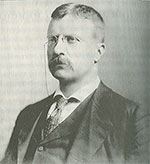 On October 25, 1899, Theodore Roosevelt, then Governor of New York, passed
through Allegany County on a four ½-hour “whistle stop” tour. While riding on the
Cumberland and Pennsylvania Railroad Roosevelt whisked like a whirlwind through the
towns of Barton, Lonaconing, Ocean, Frostburg, Mount Savage, and Cumberland.
Receptive crowds gathered by the hundreds at each train stop to hear the
electrifying speaker from New York.
On October 25, 1899, Theodore Roosevelt, then Governor of New York, passed
through Allegany County on a four ½-hour “whistle stop” tour. While riding on the
Cumberland and Pennsylvania Railroad Roosevelt whisked like a whirlwind through the
towns of Barton, Lonaconing, Ocean, Frostburg, Mount Savage, and Cumberland.
Receptive crowds gathered by the hundreds at each train stop to hear the
electrifying speaker from New York.
The conservation-minded Roosevelt certainly must have observed from his train
window as he passed through Allegany County the massive devastated condition of the
forest caused by wildfires, overgrazing, and abusive timber harvesting practices
that neglected any thought of forest regeneration and the planting of trees. About
this time inventories revealed that only about thirty percent of Maryland’s
original ninety-five percent forest cover still survived. There were no state parks
or state forests, or for that matter no national parks to which the public could
visit for outdoor recreation. Green Ridge State Forest, Rocky Gap State Park, or
Dan’s Mountain State Park did not yet exist.
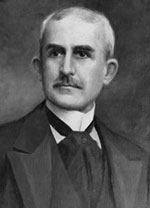 New York Governor Theodore Roosevelt, Maryland Governor Lloyd Lowndes Jr. and
U.S. Senator George Alexander Pearre arrived early that morning at Piedmont, West
Virginia on the Baltimore and Ohio Railroad. The purpose of these well-known
politicians’ presence in Allegany County was to promote the reelections of Governor
Lowndes and President William McKinley.
New York Governor Theodore Roosevelt, Maryland Governor Lloyd Lowndes Jr. and
U.S. Senator George Alexander Pearre arrived early that morning at Piedmont, West
Virginia on the Baltimore and Ohio Railroad. The purpose of these well-known
politicians’ presence in Allegany County was to promote the reelections of Governor
Lowndes and President William McKinley.
From Piedmont, the prestigious political party transferred to the Cumberland and
Pennsylvania Railroad to begin their barnstorming tour up through the Georges Creek
Valley. At each stop Roosevelt, the San Juan War hero, made mention of his role the
summer of 1898 in Cuba during the Spanish-American War. The New York Governor
assured the crowds to which he spoke that the strife caused by the Civil War, that once divided the nation , was
over. Roosevelt conveyed that at San Juan the North
and South had fought bravely together as one unit and that the recent war had
united once again the “Blue and the Gray” as one country.
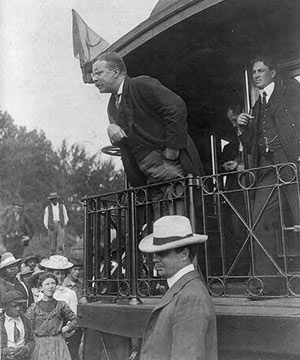 Teachers adjourned students from school to see in person Roosevelt and their
state governor. At Barton, a young boy at the train station called out for the
Rough Rider to speak. When Roosevelt’s time came to to engage the crowd from the
rear section of the train car, he commented that “miners, hunters, and cowboys” had
served honorably in his regiment. “They came from a country where men were men and
women were women,” Roosevelt said,” much like the humble people who stood before
him.
Teachers adjourned students from school to see in person Roosevelt and their
state governor. At Barton, a young boy at the train station called out for the
Rough Rider to speak. When Roosevelt’s time came to to engage the crowd from the
rear section of the train car, he commented that “miners, hunters, and cowboys” had
served honorably in his regiment. “They came from a country where men were men and
women were women,” Roosevelt said,” much like the humble people who stood before
him.
At Lonaconing, 1,100 people greeted the dignitaries. An older woman presented
Roosevelt with a “white silk muffler.” While thanking her Roosevelt mentioned that
a Lonaconing man named William Tarbet had served in his command as a Rough Rider.
After cheers for their hometown hero, a person shouted from the crowd that he was a
friend of Tarbet.
On they journeyed to Frostburg, where perhaps the party received its most
enthusiastic reception. At each town where the train stopped a reporter humorously
observed that women presented or tossed at Roosevelt such an abundance of flowers
that the war hero had to duck “flowers as he had not dodged bullets at San Juan.”
After their well-received stump speeches at Frostburg the whistle stop tour
continued and paused at Mount Savage with more speeches before continuing down
through the Jennings Run Valley and Cumberland Narrows.
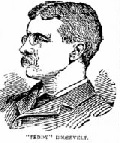 Arriving at Bedford Street in Cumberland Roosevelt transferred from the train
onto a horse drawn carriage. The party was then shuttled directly to the Academy of
Music. The Cumberland Evening Times, dated October 25, 1899, records the following
account of Roosevelt’s visit to Cumberland: “About 10:30 o’clock the South
Cumberland band marched down Baltimore Street playing a lively air at which time
the children from Union Street School were turned out and marched in great glee to
the Academy of Music and virtually took possession of the second gallery… It was
precisely eleven o’clock when Governor Roosevelt … stepped upon the stage.”
Arriving at Bedford Street in Cumberland Roosevelt transferred from the train
onto a horse drawn carriage. The party was then shuttled directly to the Academy of
Music. The Cumberland Evening Times, dated October 25, 1899, records the following
account of Roosevelt’s visit to Cumberland: “About 10:30 o’clock the South
Cumberland band marched down Baltimore Street playing a lively air at which time
the children from Union Street School were turned out and marched in great glee to
the Academy of Music and virtually took possession of the second gallery… It was
precisely eleven o’clock when Governor Roosevelt … stepped upon the stage.”
Roosevelt spoke to a standing-room only crowd of children and adults for about a
half an hour in the Hall of the Academy of Music, but it was clear to the audience
that Roosevelt was beginning to lose his voice. The last stop of the tour ended in
South Cumberland where Roosevelt gave one last speech at the railroad roundhouse
before departing Allegany County around 12:30 PM.
Less than one month after Roosevelt toured Allegany County, a fateful occurrence
set up a chain of events that had a great impact on Roosevelt’s career. On November
21, 1899, Garret Hobart, Vice President of the United States, died from a heart
condition. Shortly thereafter, in 1900, delegates chose Roosevelt to replace Hobart
as Vice President. In 1901, Roosevelt then became President of the United States
after the assassination of President McKinley.
Perhaps it was during the 1899 tour through Allegany County, when he first
observed first-hand the poor condition of Maryland’s forests, that Roosevelt
planted symbolically the first seeds of forest conservation in Maryland. These
seeds lay dormant for several years until President Roosevelt again symbolically
watered those seeds by sending to western Maryland Gifford Pinchot, Chief of the
United States Forest Service”, along with Edith Roosevelt, the First Lady, and
Theodore Roosevelt Jr., Teddy’s and Edith’s fifteen-year-old son.
 In May 1902 Pinchot’s distinguished party arrived at Oakland, MD on the B&O
Railroad. From here, Pinchot and his companions traveled ten miles to McHenry where
they stayed at a lodge along Deep Creek owned by Gus W. Delawder, former “Elected
Head” of Oakland (1879), who worked as an agent for the B&O Railroad and also
served as the Commissioner of Fisheries for Maryland. Pinchot and Delawder were
kindred spirits, for like the chief forester, Gus was “a noted authority on game
and fish and a most successful angler and hunter.” During his stay with Delawder,
Pinchot, “the Father of American Forestry” must have observed the forest
devastation that Roosevelt had witnessed earlier.
In May 1902 Pinchot’s distinguished party arrived at Oakland, MD on the B&O
Railroad. From here, Pinchot and his companions traveled ten miles to McHenry where
they stayed at a lodge along Deep Creek owned by Gus W. Delawder, former “Elected
Head” of Oakland (1879), who worked as an agent for the B&O Railroad and also
served as the Commissioner of Fisheries for Maryland. Pinchot and Delawder were
kindred spirits, for like the chief forester, Gus was “a noted authority on game
and fish and a most successful angler and hunter.” During his stay with Delawder,
Pinchot, “the Father of American Forestry” must have observed the forest
devastation that Roosevelt had witnessed earlier.
Note: Delawder entertained many prominent guests at his Deep Creek lodge
including President Grover Cleveland. An early settler of Oakland, Delawder died in
September 1906. In 1918, a fire destroyed Delawder’s Deep Creek fishing resort.
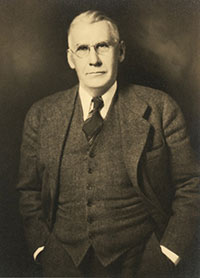 In 1906, the State of Maryland was the third state in the country to establish a
“State Board of Forestry” to oversee the management of the forestland. Pinchot
handpicked one of his federal field foresters, Fred W. Besley, to serve as
Maryland's first State Forester. Because Pinchot paid part of Besley’s salary,
Pinchot had a say regarding who worked in the Maryland State Forester position.
The seed that Roosevelt planted and Pinchot watered sprouted. Maryland’s first
State forester fertilized the symbolic conservation tree and it thrived for many
years with the caring stewardship of the land.
In 1906, the State of Maryland was the third state in the country to establish a
“State Board of Forestry” to oversee the management of the forestland. Pinchot
handpicked one of his federal field foresters, Fred W. Besley, to serve as
Maryland's first State Forester. Because Pinchot paid part of Besley’s salary,
Pinchot had a say regarding who worked in the Maryland State Forester position.
The seed that Roosevelt planted and Pinchot watered sprouted. Maryland’s first
State forester fertilized the symbolic conservation tree and it thrived for many
years with the caring stewardship of the land.
Besley brought experience and knowledge to the State Forester position that he
had gained working as the superintendent of the tree nursery in Halsey, Nebraska,
notable for being the first U.S. Forest Service tree nursery in the country.
In 1914, Besley pioneered and championed the development of the state tree
nursery at College Park. The establishment of the state tree nursery significantly
aided Besley's efforts to restore Maryland's devastated forests. Wise forest
management restored the forests of Maryland. One measurement of the many successes
that occurred is that where there were no state parks or state forests at the
beginning of twentieth century, Maryland today enjoys 9 state forests and 66 state
parks where 13 million people annually visit to enjoy the great outdoors, creating
untold positive benefits for the economy, community, and environment. The
environmental achievements set in motion in western Maryland a little more than 100
years ago by Roosevelt, Pinchot, and Besley are considered today the prologue to
the greatest Maryland conservation story ever told.
Note: Originally published in Allegany Magazine, July 2016 edition
Sources:
Zumbrun, Francis Champ. Fred W. Besley: Forestry Pioneer. 5 November 2005. 3 June 2015 .
Zumbrun, Francis Champ. Fred W. Besley: Maryland’s First State Forester 1906 -
1942.
Mayor Roster for Oakland, Maryland
“Very Rough Riding; Of the Roosevelt-Lowndes Tour in this County.” Cumberland
Evening Times, October 25, 1899. pp.1,4.